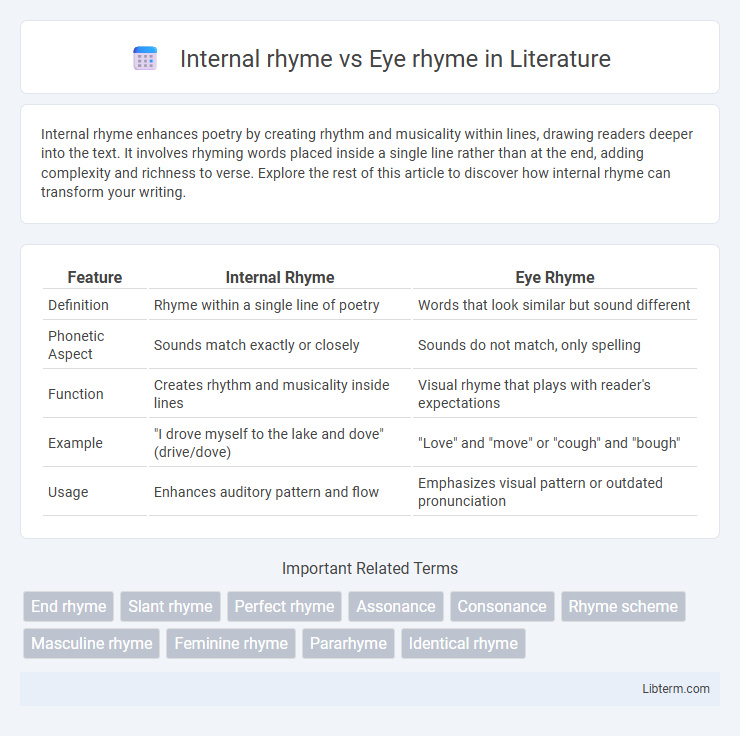Internal rhyme enhances poetry by creating rhythm and musicality within lines, drawing readers deeper into the text. It involves rhyming words placed inside a single line rather than at the end, adding complexity and richness to verse. Explore the rest of this article to discover how internal rhyme can transform your writing.
Table of Comparison
| Feature | Internal Rhyme | Eye Rhyme |
|---|---|---|
| Definition | Rhyme within a single line of poetry | Words that look similar but sound different |
| Phonetic Aspect | Sounds match exactly or closely | Sounds do not match, only spelling |
| Function | Creates rhythm and musicality inside lines | Visual rhyme that plays with reader's expectations |
| Example | "I drove myself to the lake and dove" (drive/dove) | "Love" and "move" or "cough" and "bough" |
| Usage | Enhances auditory pattern and flow | Emphasizes visual pattern or outdated pronunciation |
Understanding Internal Rhyme
Internal rhyme involves rhyming words within a single line of poetry, enhancing rhythm and musicality by creating sound patterns that link ideas more closely than end rhymes. This technique differs from eye rhyme, where words appear to rhyme based on spelling but do not produce matching sounds, often leading to visual rather than auditory emphasis. Recognizing internal rhyme deepens comprehension of a poem's auditory texture and helps identify the poet's intentional soundplay to convey mood and meaning.
What Is Eye Rhyme?
Eye rhyme occurs when two words appear to rhyme because of similar spelling but differ in pronunciation, such as "love" and "move." This type of rhyme relies on visual similarity rather than phonetic agreement, often seen in older poetry and English spelling inconsistencies. Eye rhyme contrasts with internal rhyme, which involves rhyming words within a single line based on sound rather than spelling.
Key Differences Between Internal and Eye Rhyme
Internal rhyme occurs within a single line of poetry, creating sound repetition that enhances rhythm and musicality, while eye rhyme relies on similar spelling rather than sound, often misleading the reader's expectations of rhyme. Internal rhyme involves phonetic similarity inside the line, such as "The fair breeze blew, the white foam flew," whereas eye rhyme pairs words like "love" and "move," which look alike but do not rhyme when spoken. The key difference lies in internal rhyme's auditory effect contrasted with the visual similarity emphasized in eye rhyme.
Examples of Internal Rhyme in Poetry
Internal rhyme occurs when words within the same line of poetry share similar sounds, enhancing rhythm and musicality, such as in Edgar Allan Poe's "Once upon a midnight dreary, while I pondered, weak and weary." Examples include "The fair breeze blew, the white foam flew" by Samuel Taylor Coleridge, where "blew" and "flew" rhyme inside the line. This contrasts with eye rhyme, where words look alike but do not sound alike, like "love" and "move.
Famous Uses of Eye Rhyme
Eye rhyme frequently appears in classic poetry, such as Shakespeare's works, where words like "love" and "move" visually resemble each other but differ in sound, creating a subtle visual harmony. Emily Dickinson also employed eye rhyme to enhance the aesthetic complexity of her verses, using pairs like "cough" and "bough" to intrigue readers. This technique enriches the text by pairing visual similarity with phonetic difference, distinct from internal rhyme which relies on matching sounds within a line.
How Internal Rhyme Enhances Rhythm
Internal rhyme enhances rhythm by creating melodic patterns within a single line, which amplifies the musicality and fluidity of a poem. This technique links words through sound before the line's end, increasing the cohesiveness and driving the tempo forward. Unlike eye rhyme, which relies on visual similarity, internal rhyme directly engages the reader's auditory senses, making the rhythm more dynamic and immersive.
Eye Rhyme and Visual Appeal in Poetry
Eye rhyme, also known as visual rhyme, occurs when words appear similar in spelling but differ in pronunciation, creating a unique visual appeal in poetry. Unlike internal rhyme, which relies on matching sounds within lines, eye rhyme engages readers through familiar orthographic patterns that enhance the poem's aesthetic without relying on auditory similarity. This visual connection enriches the reader's experience by blending linguistic expectation with phonetic surprise, adding layers of meaning and texture to poetic compositions.
Challenges in Identifying Internal vs. Eye Rhyme
Identifying internal rhyme poses challenges due to its placement within a single line, often blending seamlessly with the sentence structure, making it less obvious than end rhymes. Eye rhyme, which relies on visual spelling similarities rather than phonetic matching, complicates detection because it appears to rhyme on the page but not when spoken aloud. This divergence between phonetic and visual cues requires careful analysis of both sound and orthography to accurately distinguish internal rhyme from eye rhyme.
Tips for Using Rhyme in Creative Writing
Internal rhyme involves rhyming words within the same line, creating rhythm and musicality, while eye rhyme relies on visual similarity of words without matching sounds, which can create subtle tension or irony. To use rhyme effectively in creative writing, focus on integrating internal rhyme to enhance flow and emphasize key emotions or ideas, and employ eye rhyme sparingly to intrigue readers and add a layer of complexity. Balancing these techniques with natural language ensures the rhyme enriches the narrative without disrupting readability.
Internal Rhyme vs. Eye Rhyme: Which Should You Choose?
Internal rhyme occurs within a single line, enhancing musicality and rhythm, while eye rhyme features similar spelling but different sounds, often causing a visual rather than auditory connection. Choosing between internal rhyme and eye rhyme depends on your poetic goals: internal rhyme strengthens the poem's flow and sound pattern, making it ideal for lyrical and rhythmic emphasis, whereas eye rhyme suits visual impact in written form or ironic effects. For dynamic reading experience and sonic cohesion, internal rhyme is generally preferred, but eye rhyme can add subtle complexity to the poem's visual structure.
Internal rhyme Infographic

 libterm.com
libterm.com